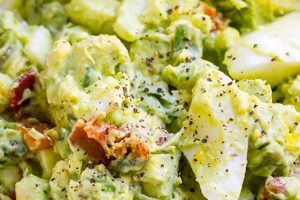An egg salad enriched with additional protein sources offers a nutritionally dense meal option. This can be achieved by incorporating ingredients like Greek yogurt, cottage cheese, or protein powder, alongside the traditional components of eggs, mayonnaise, and seasonings. For instance, a recipe might combine hard-boiled eggs, Greek yogurt, chopped celery, Dijon mustard, and a scoop of whey protein powder.
Elevating the protein content of this classic dish transforms it into a satisfying and muscle-building choice. This is particularly advantageous for individuals focused on athletic performance, weight management, or simply increasing their protein intake. Historically, egg salad has been a popular, affordable, and convenient meal. Contemporary adaptations, emphasizing higher protein content, reflect current nutritional trends and a growing awareness of the importance of protein in a balanced diet.
The following sections will delve into specific recipes for creating protein-rich egg salads, explore various protein-boosting ingredients, and offer practical tips for maximizing flavor and nutritional value.
Tips for Creating a Protein-Rich Egg Salad
Optimizing egg salad for protein content involves strategic ingredient selection and preparation methods. The following tips offer guidance for creating a nutritious and flavorful high-protein meal.
Tip 1: Choose Protein-Rich Additions. Incorporate ingredients like Greek yogurt, cottage cheese, edamame, or lentils to significantly boost the protein content. Consider whey or casein protein powder for an even greater increase.
Tip 2: Optimize Egg Cooking. Overcooked yolks can become dry and crumbly. Aim for a firm but moist yolk by cooking eggs for 8-10 minutes in boiling water, followed by an immediate ice bath.
Tip 3: Control Mayonnaise. Mayonnaise contributes flavor but can be high in fat. Use it sparingly or opt for reduced-fat alternatives like Greek yogurt or avocado.
Tip 4: Maximize Flavor with Seasonings. Enhance the taste with Dijon mustard, black pepper, paprika, garlic powder, or fresh herbs like dill and chives.
Tip 5: Incorporate Textural Variety. Add chopped celery, red onion, bell peppers, or water chestnuts for a satisfying crunch.
Tip 6: Consider Meal Pairing. Serve the egg salad on whole-grain bread, crackers, lettuce wraps, or as a filling for bell peppers or tomatoes for a complete and balanced meal.
Tip 7: Proper Storage. Store leftover egg salad in an airtight container in the refrigerator for up to 3 days.
By following these guidelines, one can create a delicious and protein-packed egg salad that supports dietary goals and provides sustained energy.
This information provides a foundation for crafting personalized protein-rich egg salad recipes tailored to individual preferences and nutritional needs.
1. Protein Sources
Protein sources are fundamental to a high-protein egg salad recipe, directly impacting its nutritional value and satiety factor. Traditional egg salad relies primarily on eggs for protein. However, augmenting the recipe with additional protein sources significantly elevates the overall protein content, transforming it into a more substantial and beneficial meal. This is achieved by incorporating ingredients rich in protein, such as Greek yogurt, cottage cheese, lean meats (like diced chicken or turkey), fish (such as flaked tuna or salmon), legumes (like chickpeas or lentils), or even protein powder. For instance, adding Greek yogurt not only boosts protein but also contributes a creamy texture, while incorporating diced chicken provides a different flavor profile and additional protein.
The choice of protein source influences not only the nutritional profile but also the flavor and texture of the egg salad. Cottage cheese offers a distinct tanginess and a slightly curdled texture, whereas flaked tuna introduces a savory, oceanic flavor. Understanding these nuances allows for customization based on individual dietary needs and preferences. Furthermore, combining different protein sources can create a more complex and balanced flavor profile while maximizing protein content. For example, a combination of eggs, Greek yogurt, and diced chicken creates a multi-textured and flavorful egg salad with a substantial protein boost. This approach allows for a wider range of nutrients and caters to diverse palates.
Strategic selection of protein sources is key to developing a high-protein egg salad recipe that meets specific dietary goals and taste preferences. Considering factors like protein content per serving, flavor compatibility, textural influence, and potential allergens allows for informed choices. The ability to adjust and combine protein sources offers flexibility and customization, ensuring the egg salad remains a versatile and nutritious meal option.
2. Healthy Fats
Healthy fats play a crucial role in a high-protein egg salad recipe, contributing to satiety, nutrient absorption, and overall flavor enhancement. While often overlooked, incorporating the right kinds of fats is essential for creating a balanced and nutritious meal. Understanding their impact on the recipe’s nutritional profile and sensory experience is vital for informed recipe development.
- Avocado:
Avocado offers monounsaturated fats, known for their heart-healthy benefits. Its creamy texture complements the egg salad, acting as a partial replacement for mayonnaise while boosting healthy fat content. This substitution contributes to a richer flavor profile and improved nutritional value.
- Olive Oil:
Extra virgin olive oil provides another source of monounsaturated fats and antioxidants. A small amount can be drizzled over the egg salad to enhance its flavor and contribute to a smoother texture. Olive oil offers a distinct flavor profile compared to mayonnaise, adding a subtle fruitiness to the dish.
- Nuts and Seeds:
Chopped walnuts, almonds, or sunflower seeds introduce polyunsaturated fats, including omega-3 fatty acids, alongside added protein and fiber. These additions contribute a satisfying crunch and enhance the nutritional density of the egg salad. However, portion control is crucial due to their calorie density.
- Fatty Fish:
Incorporating flaked salmon or tuna not only boosts protein content but also introduces omega-3 fatty acids. These healthy fats contribute to the overall nutritional value of the egg salad and offer a distinct savory flavor profile. This addition transforms the traditional egg salad into a more substantial and nutrient-rich meal.
Strategic incorporation of healthy fats elevates the high-protein egg salad from a simple dish to a nutritionally balanced meal. These fats not only contribute to satiety and flavor but also play a crucial role in the absorption of fat-soluble vitamins. The choice of fat source significantly impacts the final product’s taste and nutritional profile, allowing for customization based on individual dietary needs and preferences.
3. Flavorful Seasonings
Flavorful seasonings are essential for elevating a high-protein egg salad recipe beyond basic nutrition to a truly enjoyable culinary experience. The inherent mildness of eggs and many protein-boosting additions, such as Greek yogurt or cottage cheese, necessitates the strategic use of seasonings to create a balanced and appealing flavor profile. Seasonings not only enhance taste but also contribute to the overall sensory experience, making the dish more palatable and satisfying. This is particularly important when incorporating ingredients with potentially strong or less desirable flavors, such as certain protein powders or strong-tasting fish. For example, a pinch of smoked paprika can add depth and complexity, while a squeeze of lemon juice can provide brightness and cut through richness. Fresh herbs like dill or chives introduce a refreshing element, while spices like curry powder or cumin can create an entirely different flavor profile, transforming the traditional egg salad into a more exotic culinary creation. The careful balance of seasonings can mask any unwanted tastes from added protein sources and elevate the overall flavor profile, ensuring a delicious and satisfying meal.
The interplay between seasonings and other ingredients is crucial. The saltiness of capers, the tanginess of Dijon mustard, or the sweetness of chopped red onion each contribute a unique dimension to the flavor profile. Understanding these interactions allows for the creation of complex and well-balanced flavor combinations. Consider the combination of Dijon mustard and dill, which complement each other to create a classic egg salad flavor, or the use of curry powder and chopped apples for a more unique and flavorful experience. The versatility of egg salad allows for a wide range of flavor explorations, catering to diverse palates and culinary preferences. Furthermore, the choice of seasonings can be tailored to complement specific dietary needs, such as reducing sodium intake by using herbs and spices instead of relying solely on salt.
Effective use of seasonings transforms a high-protein egg salad from a purely functional meal into a delightful culinary experience. This aspect, often overlooked, is paramount to ensuring consistent enjoyment and encouraging adherence to dietary goals that incorporate this nutritious dish. The strategic application of seasonings allows for endless variations and customizations, making the high-protein egg salad a versatile and adaptable component of a healthy and enjoyable diet.
4. Textural Elements
Textural elements contribute significantly to the overall enjoyment and satisfaction derived from a high-protein egg salad recipe. A monotonous texture can detract from the eating experience, even if the flavor profile is well-balanced. Strategic incorporation of ingredients offering contrasting textures elevates the dish from simple sustenance to a more engaging culinary experience. This is particularly relevant for high-protein egg salads, as the addition of protein sources like Greek yogurt or cottage cheese can sometimes result in a denser, creamier texture than traditional egg salad. The interplay of textures creates a more dynamic and enjoyable sensory experience, encouraging consumption and contributing to a positive perception of the meal. For instance, the smoothness of the egg yolks and added dairy can be offset by the crispness of chopped celery or the crunch of chopped walnuts, creating a multi-faceted textural profile that enhances enjoyment.
Consider the contrast between the soft, yielding texture of hard-boiled egg whites and the creamy richness of avocado. Adding finely diced red onion introduces a sharp, pungent bite, while incorporating chopped water chestnuts provides a crisp, refreshing contrast. These textural variations prevent the egg salad from becoming bland and homogenous, creating a more dynamic and satisfying culinary experience. Furthermore, textural elements can influence perceived satiety. A combination of smooth and crunchy elements can contribute to a feeling of fullness, which is particularly relevant for those seeking a protein-rich meal for weight management purposes. The inclusion of fiber-rich vegetables like chopped bell peppers or shredded carrots not only adds textural complexity but also contributes to dietary fiber intake, further enhancing the nutritional value of the egg salad.
Achieving optimal textural variety in a high-protein egg salad involves careful consideration of ingredient selection and preparation techniques. Dicing vegetables into uniform pieces ensures even distribution of texture throughout the salad, while coarsely chopping nuts or seeds provides larger, more pronounced bursts of crunch. Understanding the impact of different knife cuts and preparation methods on the final texture allows for precise control over the sensory experience. This attention to detail elevates the high-protein egg salad from a simple, functional meal to a carefully crafted dish that is both nutritious and enjoyable to consume. Ultimately, the interplay of textures enhances the overall appeal and satisfaction derived from this protein-packed meal.
5. Preparation Methods
Preparation methods significantly influence the final quality and nutritional value of a high-protein egg salad. Careful consideration of each step, from ingredient preparation to final assembly, ensures optimal flavor, texture, and protein retention. Overlooking seemingly minor details can compromise the overall result, impacting both palatability and nutritional benefits.
- Egg Cooking Technique
Proper egg cooking is fundamental. Overcooking leads to dry, crumbly yolks and a less appealing texture. Conversely, undercooking poses food safety risks. The ideal hard-boiled egg for egg salad has a firm, yet moist yolk. Achieving this requires precise timing and temperature control. A recommended method involves boiling eggs for 8-10 minutes, followed by immediate immersion in an ice bath to halt the cooking process. This method ensures a perfectly cooked yolk while preventing the formation of a greenish ring around the yolk, which indicates overcooking.
- Ingredient Incorporation
The order and method of ingredient incorporation affect the final consistency and flavor distribution. Adding dry ingredients like spices and protein powder before wet ingredients, such as mayonnaise or Greek yogurt, can lead to clumping and uneven flavor. A more effective approach involves mixing wet ingredients first to create a smooth base, followed by the gradual incorporation of dry ingredients and chopped components. This ensures even distribution and prevents dry pockets within the egg salad. For instance, blending Greek yogurt and seasonings before adding chopped eggs and vegetables creates a more cohesive and flavorful mixture.
- Chopping Consistency
Uniform chopping of ingredients contributes to a more aesthetically pleasing and palatable egg salad. Unevenly chopped components can lead to an unbalanced texture and inconsistent flavor distribution. Maintaining a consistent chop size, whether dicing, mincing, or chopping, ensures a harmonious blend of flavors and textures. For example, finely dicing all vegetables creates a smoother, more uniform texture, whereas a coarser chop introduces textural variation. The chosen chopping method should align with the desired final texture and visual appeal of the salad.
- Chilling Time
Allowing the egg salad to chill in the refrigerator for at least 30 minutes after preparation allows the flavors to meld and the texture to firm up. This enhances the overall sensory experience. Chilling also improves food safety by inhibiting bacterial growth. The cold temperature enhances the perception of flavors and creates a more refreshing and enjoyable dining experience.
Careful attention to these preparation methods ensures a high-protein egg salad that is both nutritionally sound and palatable. The interplay of these techniques influences the final product’s flavor, texture, and overall appeal, maximizing the benefits of this protein-rich dish.
6. Serving Suggestions
Serving suggestions are integral to maximizing the versatility and appeal of a high-protein egg salad recipe. While the nutritional value and flavor profile are paramount, the manner of presentation significantly influences perceived satisfaction and integration into varied dietary contexts. Thoughtful serving suggestions transform the egg salad from a simple component into a versatile element adaptable to diverse meal structures and individual preferences.
Serving the egg salad on whole-grain bread or crackers provides a balanced combination of protein, healthy carbohydrates, and fiber. This approach offers a convenient and portable meal option, suitable for lunches or quick snacks. Alternatively, using lettuce wraps or endive leaves creates a lower-carbohydrate, gluten-free option, aligning with specific dietary restrictions or preferences. For a visually appealing and nutrient-rich presentation, the egg salad can be served as a filling for halved avocados or bell peppers. This method not only adds visual interest but also incorporates additional vitamins, minerals, and healthy fats. Furthermore, incorporating the egg salad into a larger meal, such as a salad bowl with mixed greens, roasted vegetables, and a light vinaigrette, offers a balanced and complete meal option. This demonstrates the adaptability of high-protein egg salad as a component within a broader dietary framework.
Effective serving suggestions broaden the practical application of high-protein egg salad recipes, facilitating integration into various dietary patterns and lifestyle contexts. The adaptability of this dish, when paired with creative serving suggestions, promotes adherence to nutritional goals without sacrificing enjoyment or convenience. Consideration of individual dietary needs, taste preferences, and lifestyle demands ensures the egg salad remains a versatile and appealing component of a healthy and enjoyable diet.
Frequently Asked Questions
This section addresses common inquiries regarding high-protein egg salad recipes, offering concise and informative responses to facilitate informed decision-making and optimal recipe utilization.
Question 1: What are the primary benefits of consuming a high-protein egg salad?
Benefits include increased satiety, support for muscle growth and repair, and contribution to overall daily protein intake goals. These factors make it a suitable meal option for individuals focused on fitness, weight management, or simply maintaining a balanced diet.
Question 2: How can one increase the protein content of a standard egg salad recipe?
Protein content can be elevated through the incorporation of ingredients such as Greek yogurt, cottage cheese, lean meats, fish, legumes, or protein powder. Strategic selection of these additions allows for customization based on individual dietary preferences and protein targets.
Question 3: What are suitable healthy fat sources to include in a high-protein egg salad?
Avocado, olive oil, nuts, seeds, and fatty fish offer beneficial fats that enhance flavor, contribute to satiety, and support nutrient absorption. These additions improve the nutritional profile of the egg salad without compromising its palatability.
Question 4: How long can high-protein egg salad be safely stored in the refrigerator?
Properly stored in an airtight container, high-protein egg salad typically remains safe for consumption for up to three days in the refrigerator. Beyond this timeframe, the risk of bacterial growth increases, potentially compromising food safety.
Question 5: Can high-protein egg salad be frozen for later consumption?
Freezing is generally not recommended, as the texture and consistency of the egg salad can be negatively affected upon thawing. The emulsion can break down, resulting in a watery and less desirable texture.
Question 6: Are there vegetarian or vegan alternatives for creating a high-protein egg salad?
Vegan alternatives utilize tofu or chickpeas as a base, combined with vegan mayonnaise and protein-rich additions like edamame or nutritional yeast. These adaptations provide plant-based protein sources while maintaining the characteristic flavor profile of egg salad.
Understanding these key aspects of high-protein egg salad recipes ensures optimal preparation, storage, and integration into a balanced dietary plan.
The subsequent sections will provide specific recipe examples and further explore variations tailored to individual dietary needs and preferences.
Conclusion
Exploration of high-protein egg salad recipes reveals a versatile and adaptable dish capable of meeting diverse nutritional needs and culinary preferences. Strategic ingredient selection, encompassing protein sources, healthy fats, and flavorful seasonings, is essential for optimizing both nutritional value and palatability. Careful consideration of preparation methods, from egg cooking techniques to ingredient incorporation, ensures optimal texture and flavor. Serving suggestions further enhance the dish’s adaptability, facilitating integration into a wide range of meal plans and dietary contexts. Understanding these key elements empowers informed choices, promoting culinary satisfaction alongside nutritional benefit.
High-protein egg salad stands as a testament to the potential for transforming simple ingredients into nutritionally dense and flavorful meals. Continued exploration of ingredient combinations and preparation techniques offers opportunities for further refinement and personalization. This adaptability positions high-protein egg salad as a valuable component within a balanced and health-conscious dietary approach.






